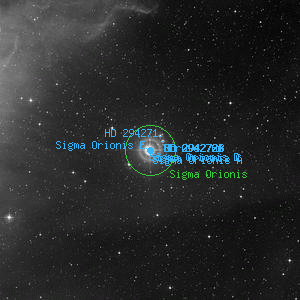Sigma Orionis

Overlaid DSS image of Sigma Orionis, 60' x 60' with north at top and west to the right
Aladin viewer for the region around Sigma Orionis
Sigma Orionis Cluster, Sigma Orionis Association, Sigma Orionis Group, σ Ori, 48 Ori
Σ 762, C 0536-026, WDS J05387-0236
Σ 762, C 0536-026, WDS J05387-0236
| Type | Open Cluster |
|---|---|
| Magnitude | 3.7 |
| Size | 10' |
| Right Ascension | 5h 38' 44.8" (2000) |
| Declination | 2° 36' 0" S |
| Constellation | Orion |
Observing Notes
Andrew Cooper
Nov 26, 2022 Waikoloa, HI (map)
28cm f/10 SCT, NexStar 11" GyPSy @ 127x
Seeing: 6 Transparency: 7 Moon: 0%
A lovely group of stars centered on a bright 4th magnitude blue-white primary, the group includes a half dozen 7-9th magnitude stars spanning a 10' area, while the AB 0.3" pair is not visibly split, the central group of AB, C, D, and E is striking in the eyepiece.
A little WDS mayhem now commences...A - Blue-white 4th magnitudeAll of these stars do appear to be physically related, with matching parallax values very near 2.5mas and low proper motions (Gaia EDR3). The stars of Σ761 are part of the σ Ori group, visible 3' northwest including a notable 8th magnitude 8" pair.
B - 0.3" 5th magnitude not visible
C - An 8th magnitude 12" @ 240° easily visible
D - A bright 7th magnitude visible 12" @ 80°
E - A bright 7th magnitude visible 40" @ 60°
F - An 8th magnitude visible 200" @ 325°
G - A 12th magnitude 3" not visible
H - An 8th magnitude visible 300" @ 125°
I - An 8th magnitude visible 525" @ 60°
Apparently C is a 2" double, the 14th magnitude companion not visible. E is also double at 0.3", and A itself is a spectroscopic binary.
The question can be posed... Is this a multiple star system or a small open cluster? Personally I think a cluster may be a better description. Though none of the stellar cartographers have seen fit to give it a place in one of the many cluster catalogs there is recognition of the Sigma Orionis Cluster or Sigma Orionis Association in a number of published papers.
The σ Ori group is in a rich region 1° south of Alnitak, the entire area spectacular in the eyepiece.
Captain William Henry Smyth
Feb 17, 1832 No. 6 The Crescent, Bedford, England (map)
150mm f/17.6 refractor by Tully 1827
A multiple star, just below the belt of Orion, forming a scalene triangle with ζ and ε. A 4, bright white; all, ash-coloured; B 8, bluish; C 7, grape red; D 8½, dusky; E 9, white; F 8, pale grey. This is a fine group of 10 members, forming 10 and 11 ♅. II., where it is denominated "a double-treble star, or two sets of treble stars almost similarly situated;" H. and S. call it "a very pretty double-triple star;" but Professor Barlow, with greater precision, says it is " double-quadruple, with two very fine stars between the sets." As some of these lie at a great distance, I measured to the uncials of H. and S., with only the addition a, to the bright, or following set. By reducing Σ.'s observations to one epoch, and arranging his letters and quadrants to quadrate with ours, the scale of comparison will be:♅. 1779.77As this is a good object for trying the light and definition of a telescope, and the following of its groups is both delicate and pretty as a quadruple set, the explorer is recommended to examine it when in apparition. Nor need he be very much annoyed with his instrument, should he be unable to distinguish the minute comes a; since it is so small a point of light, that it escaped even the searching eye of ♅. This group may be readily fished up, as it forms the southern vertex of a triangle with the two last stars in the belt, as above stated; and it is rather less than a degree from ζ in the direction of Rigel.
A a (not seen)
AB Pos. 84° 55' Dist. 13".44
AC 60° 55' 43".20
AD (not measured)
DE 267° 00'±
DF 23° 25'
H. and S. 1823.13
A a (not seen)
AB Pos. 83° 19' Dist. 12".91
AC 61° 03' 42".77
AD 322° 57' 210".26
DE 266° 21' 11".14
DF 2°1 49' 68".26
Σ. 1831.06
Aa Pos. 236° 52' Dist. 11".01
AB 84° 30' 12".86
AC 59° 55' 4l".60
AD (not measured)
DE 267° 51' 8".35
DF 21° 35' 68".08― A Cycle of Celestial Objects Vol II, The Bedford Catalogue, William Henry Smyth, 1844
Other Data Sources for Sigma Orionis
Associated objects for Sigma Orionis
| HD 294271 | HD 294272 | HD 294272A |
| HD 294272B | Sigma Orionis A | Sigma Orionis C |
| Sigma Orionis D | Sigma Orionis E | Struve 761 |
Nearby objects for Sigma Orionis
18 objects found within 60'
Credits...
Drawings, descriptions, and CCD photos are copyright Andrew Cooper unless otherwise noted, no usage without permission.
A complete list of credits and sources can be found on the about page
Sigma Orionis